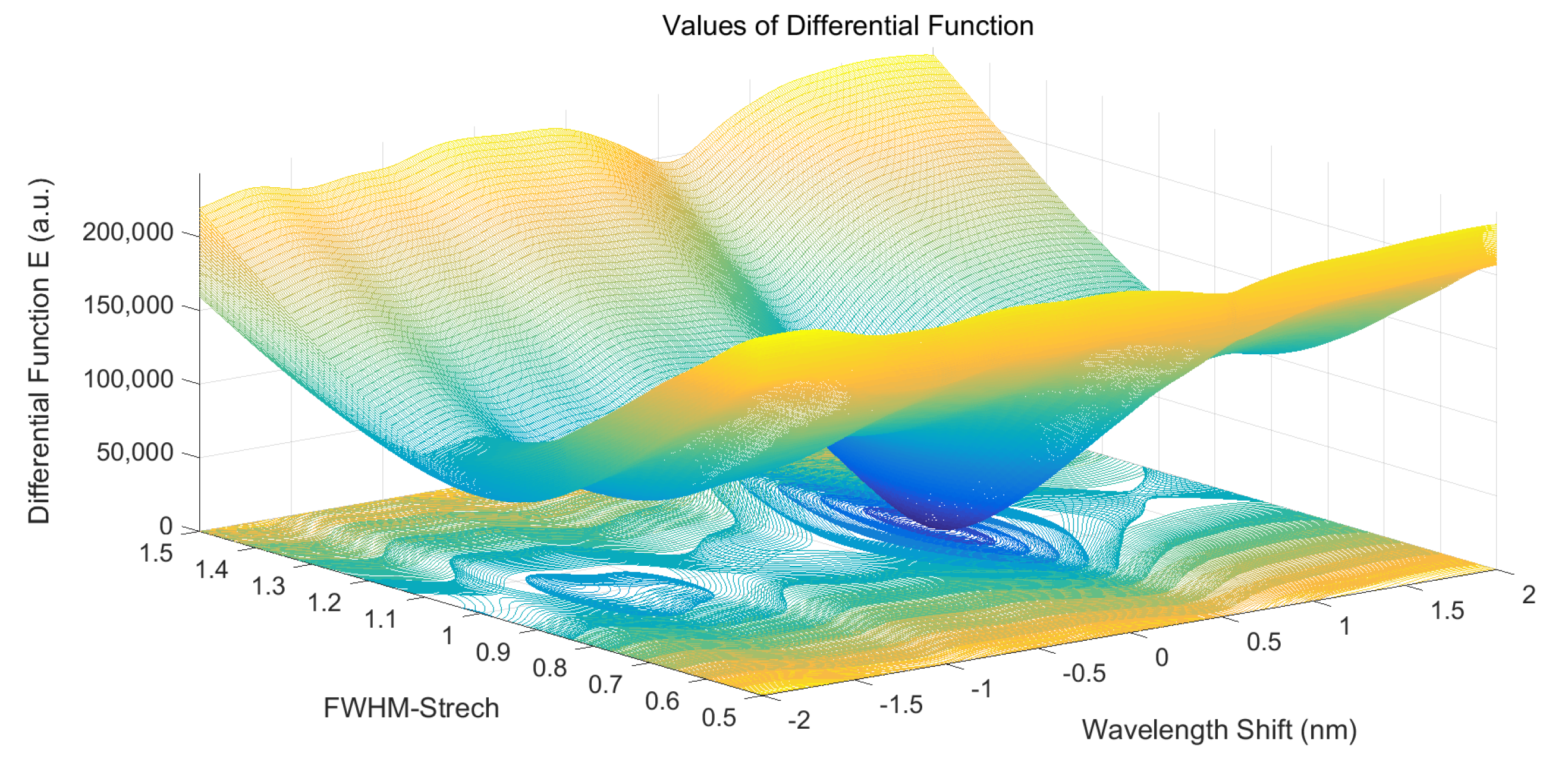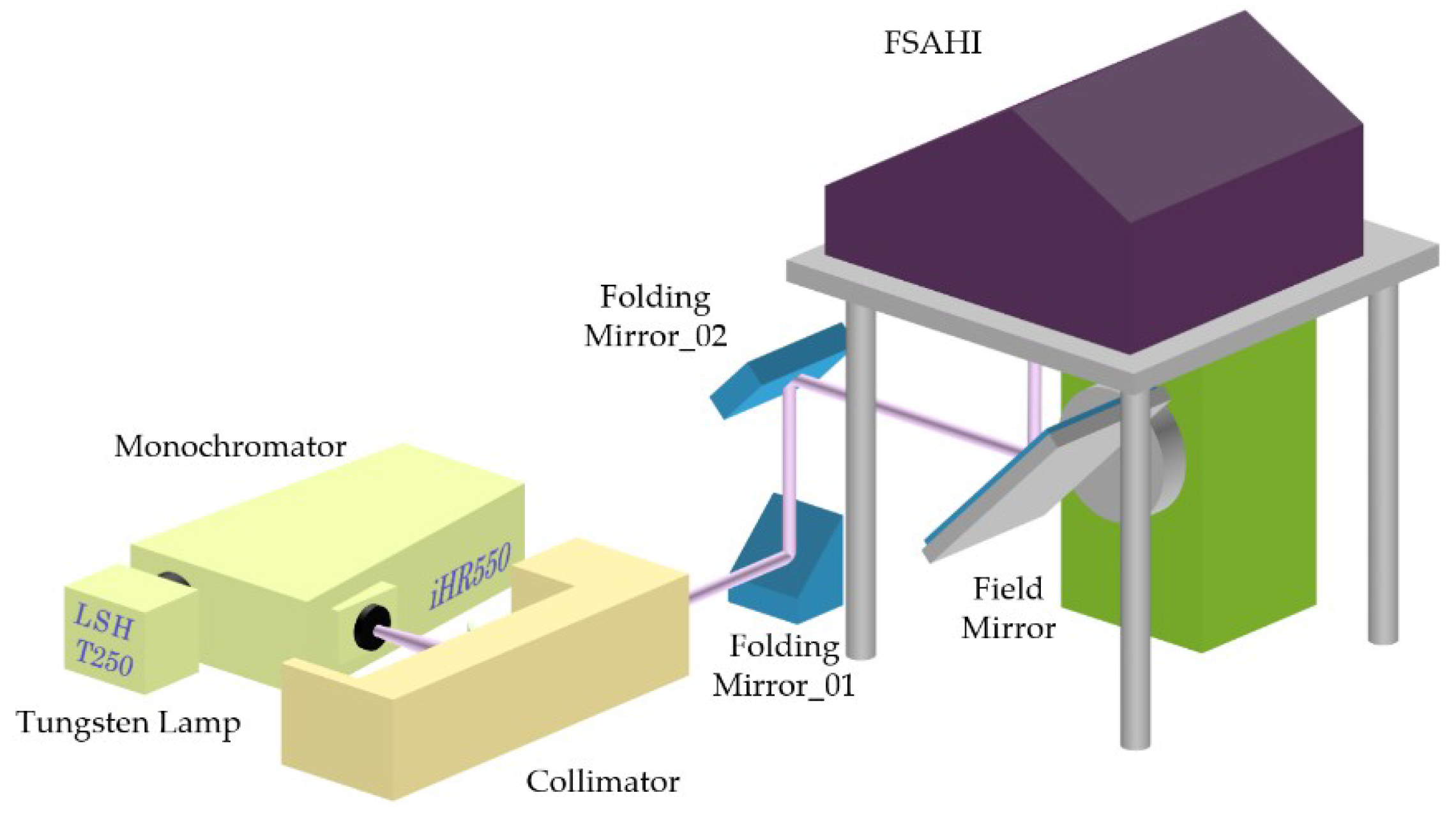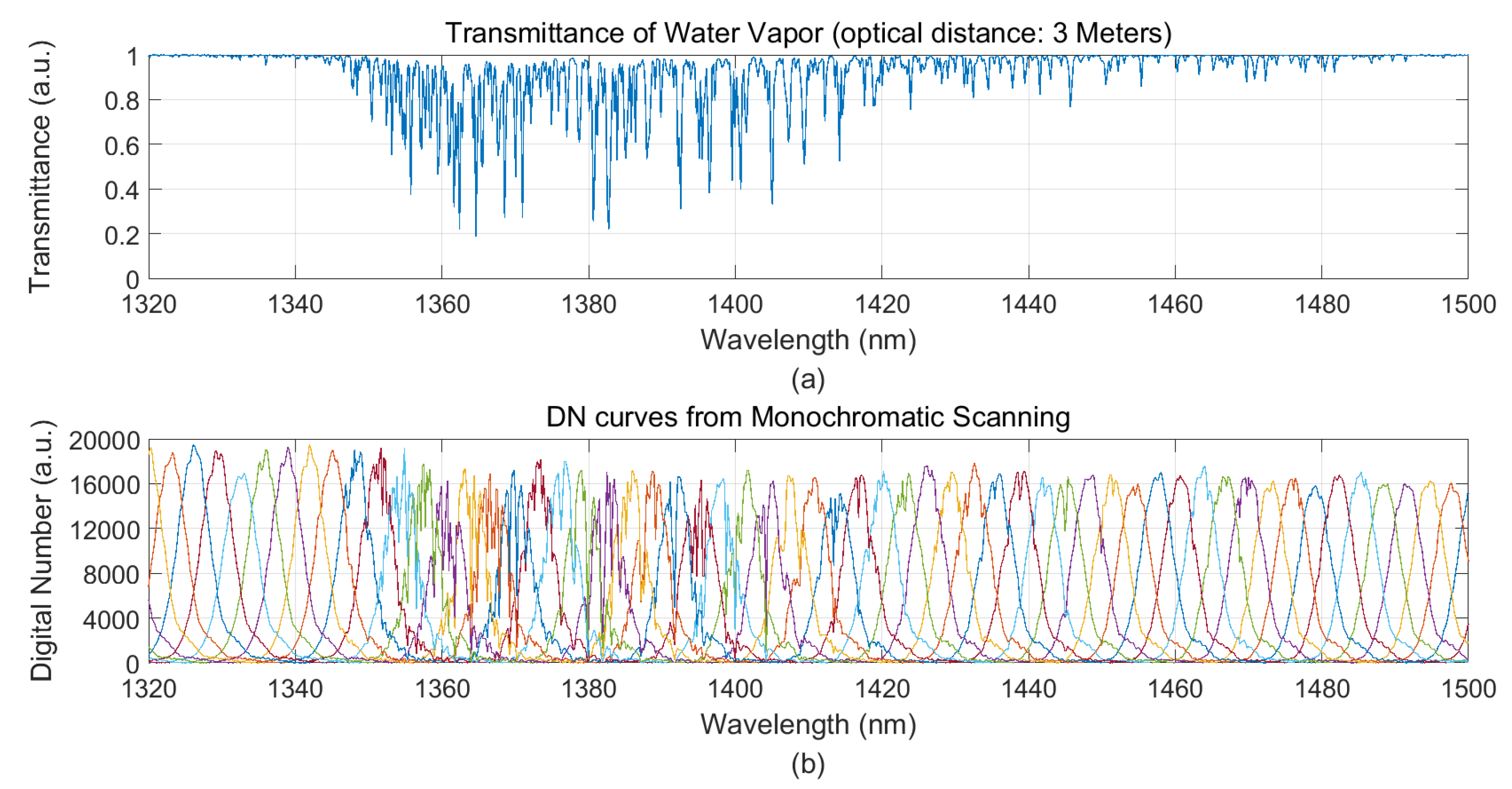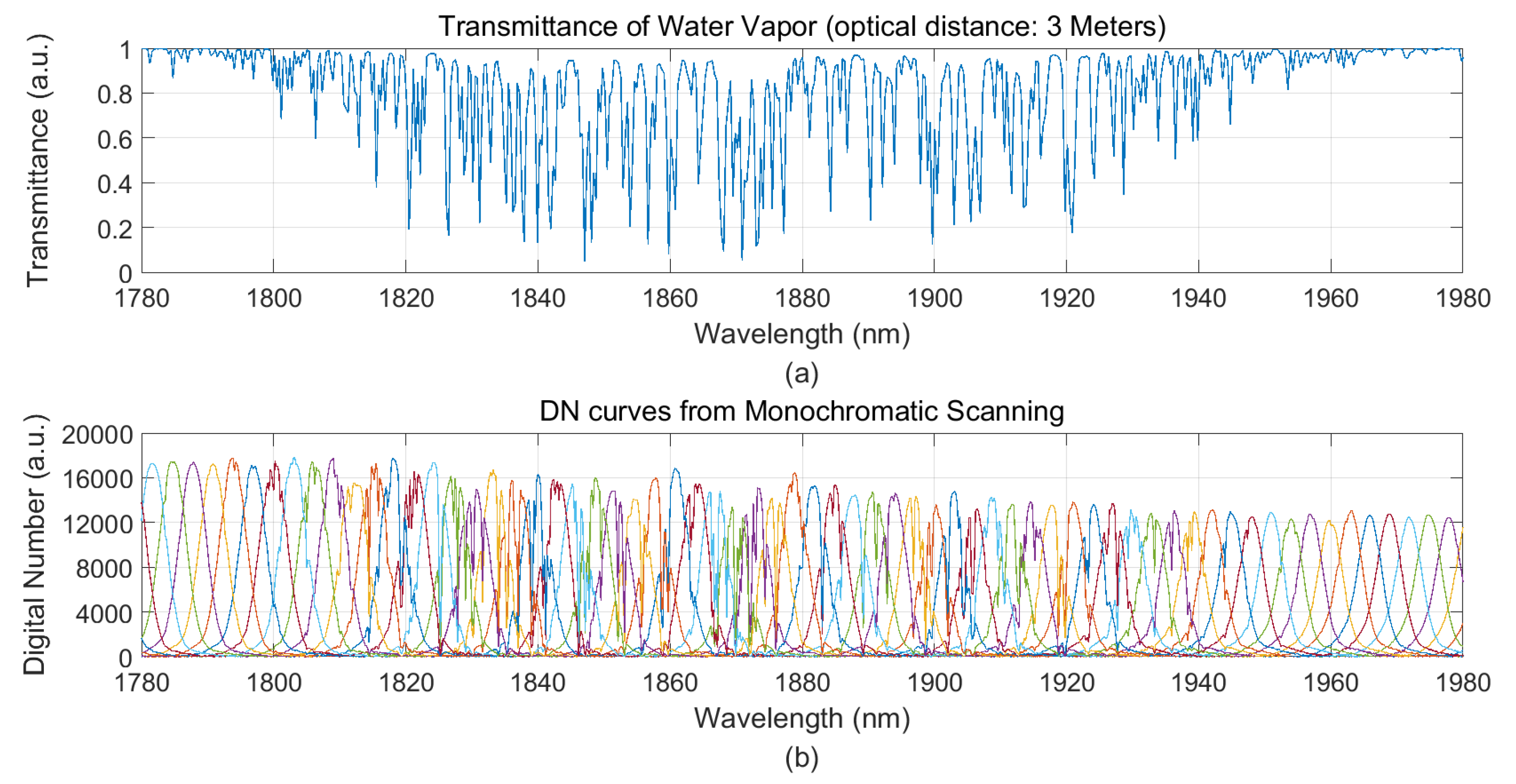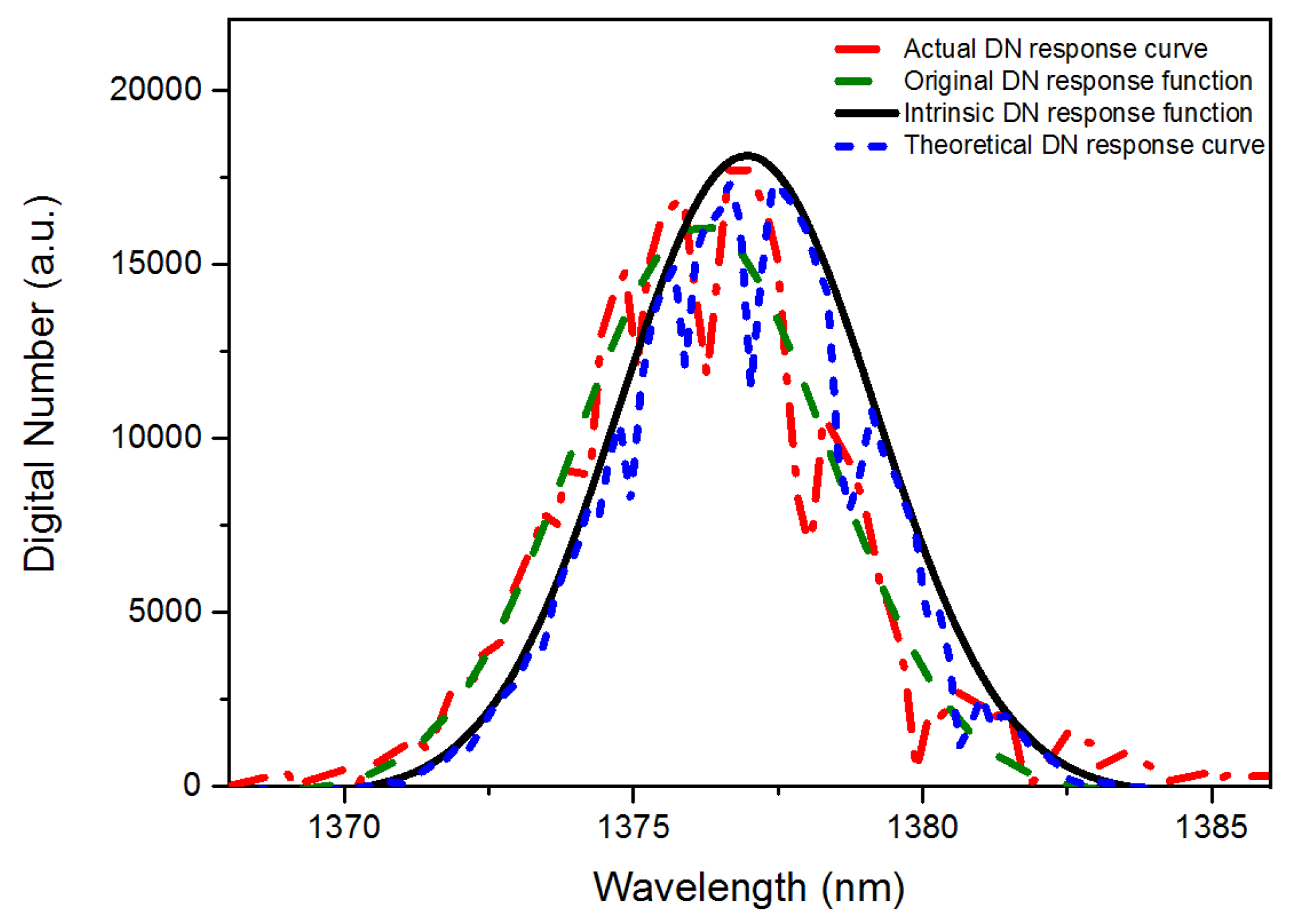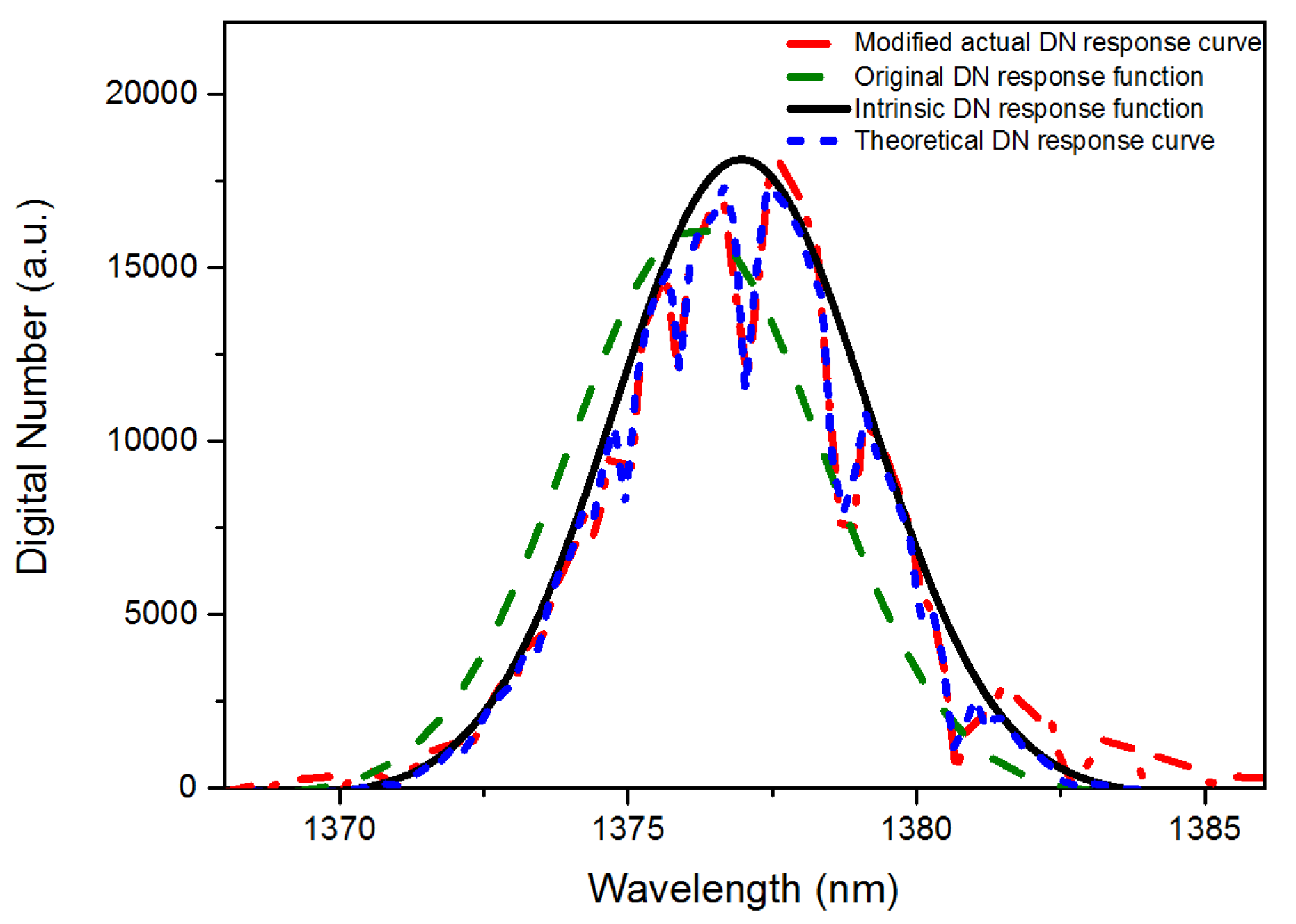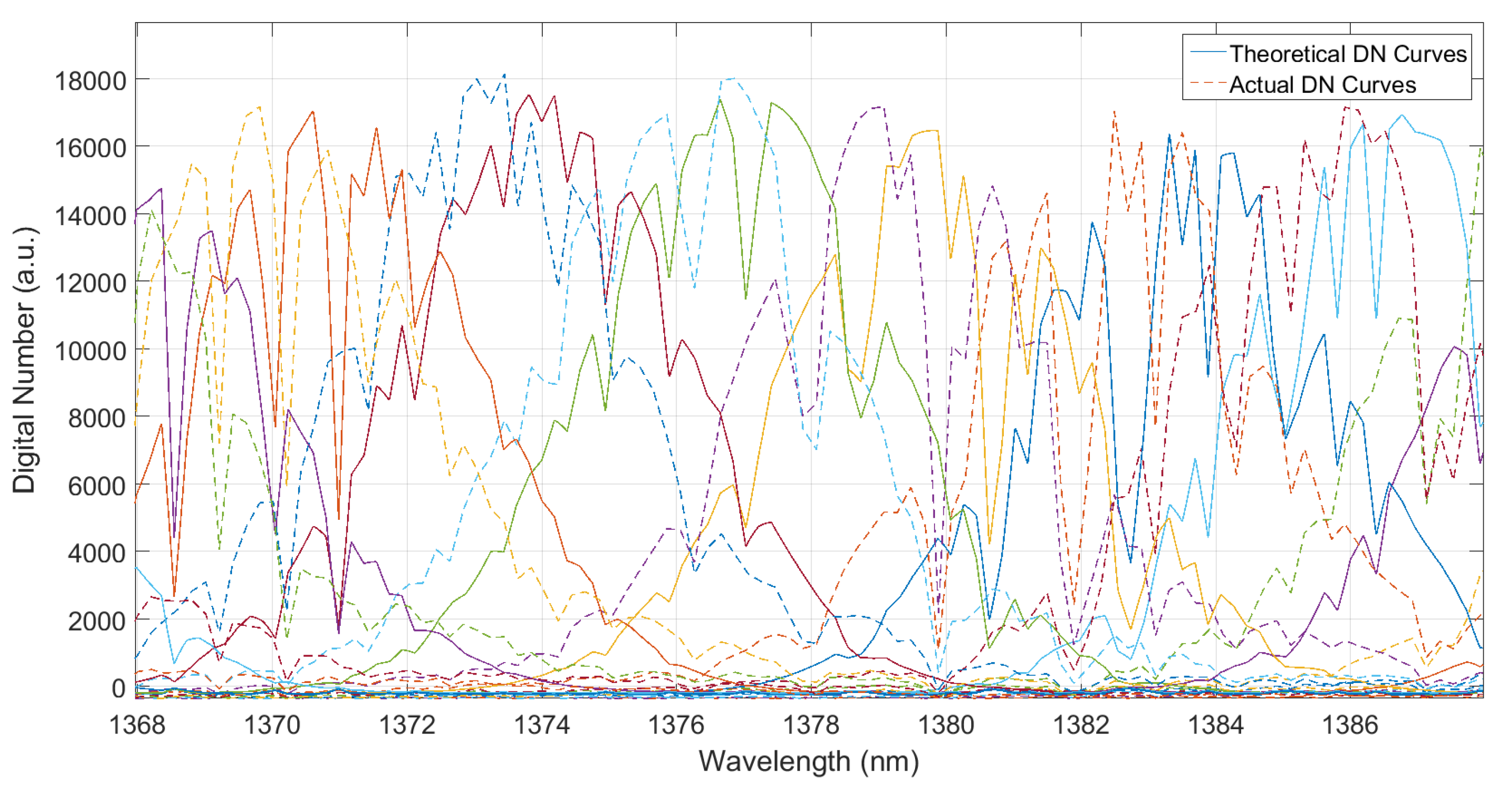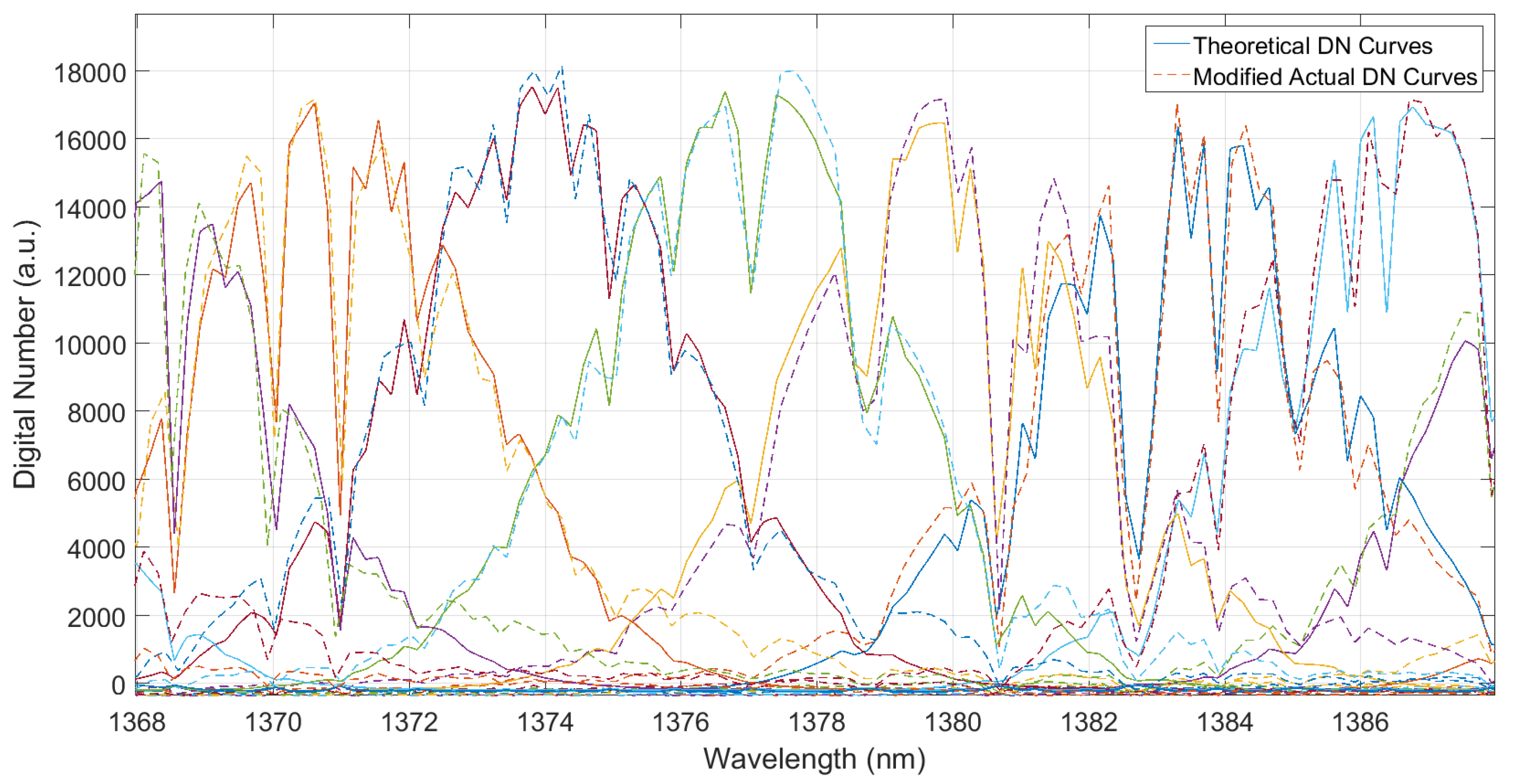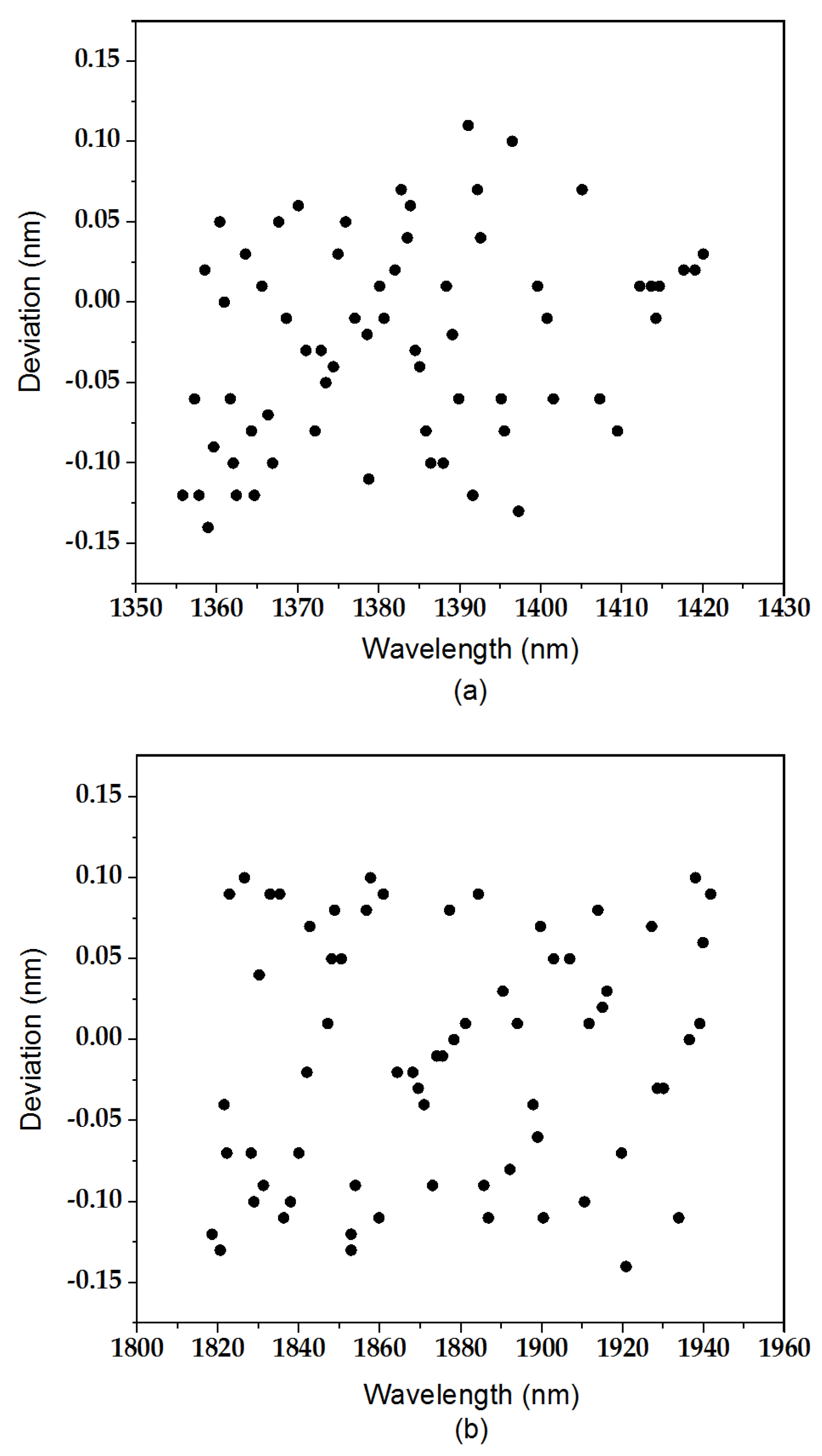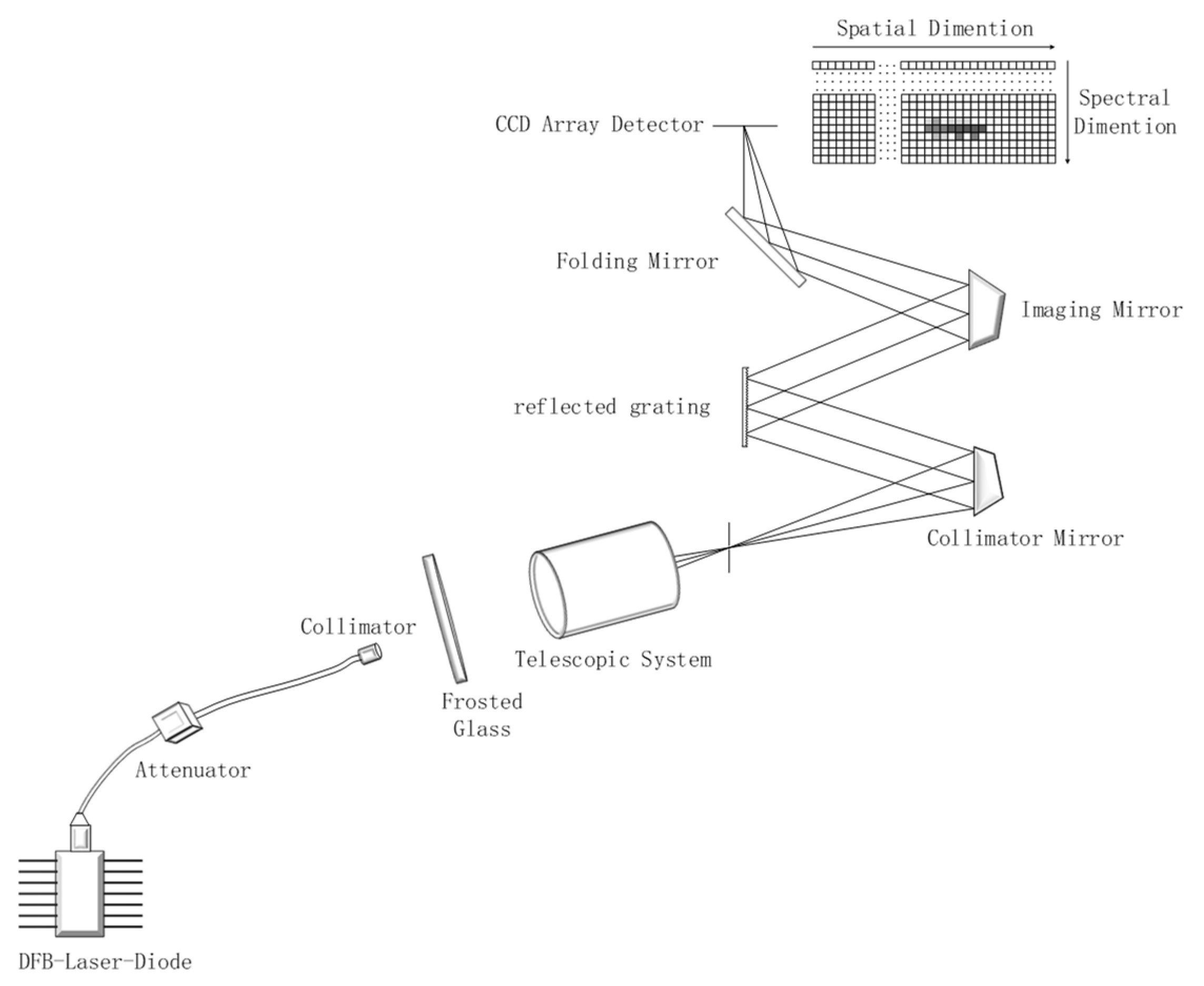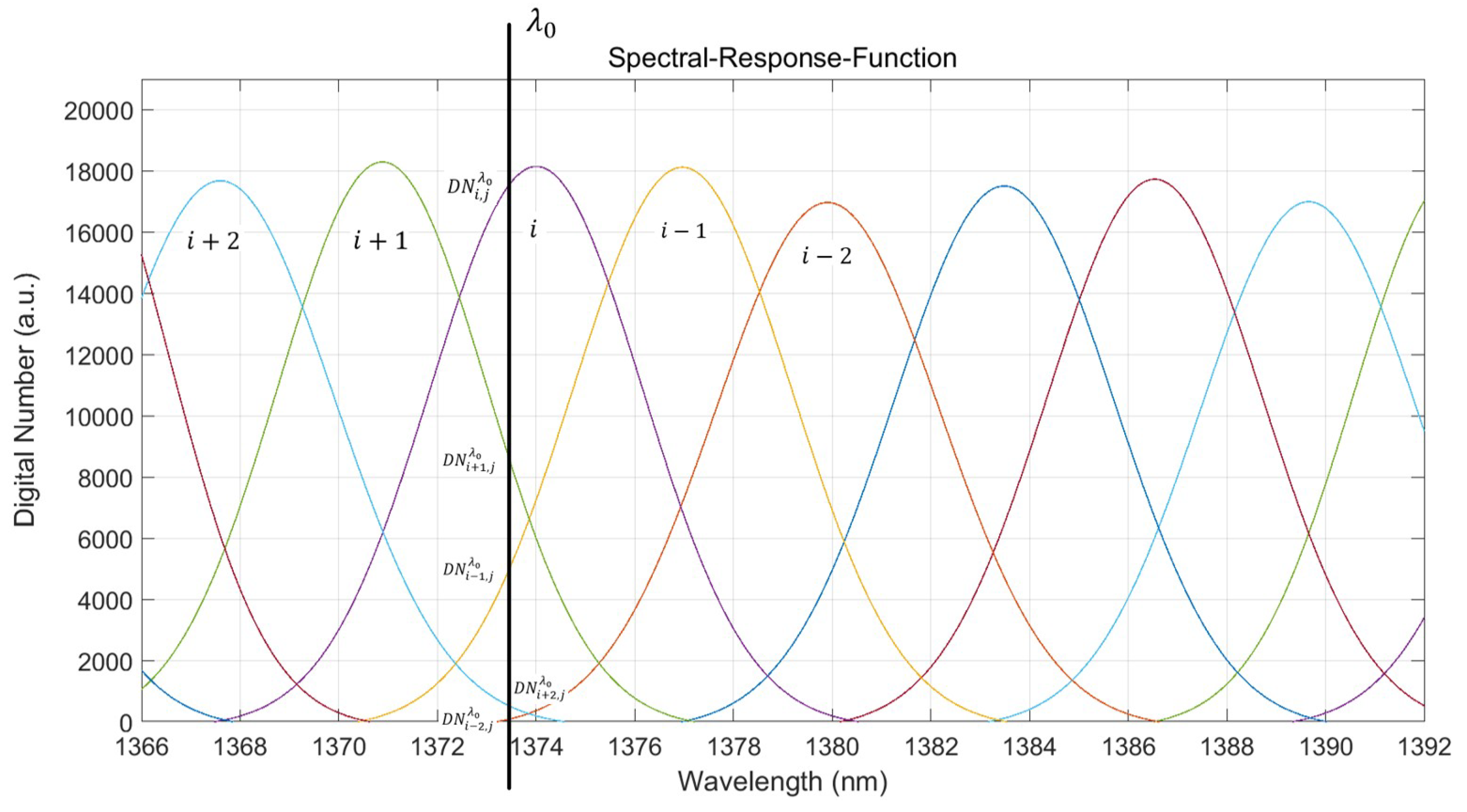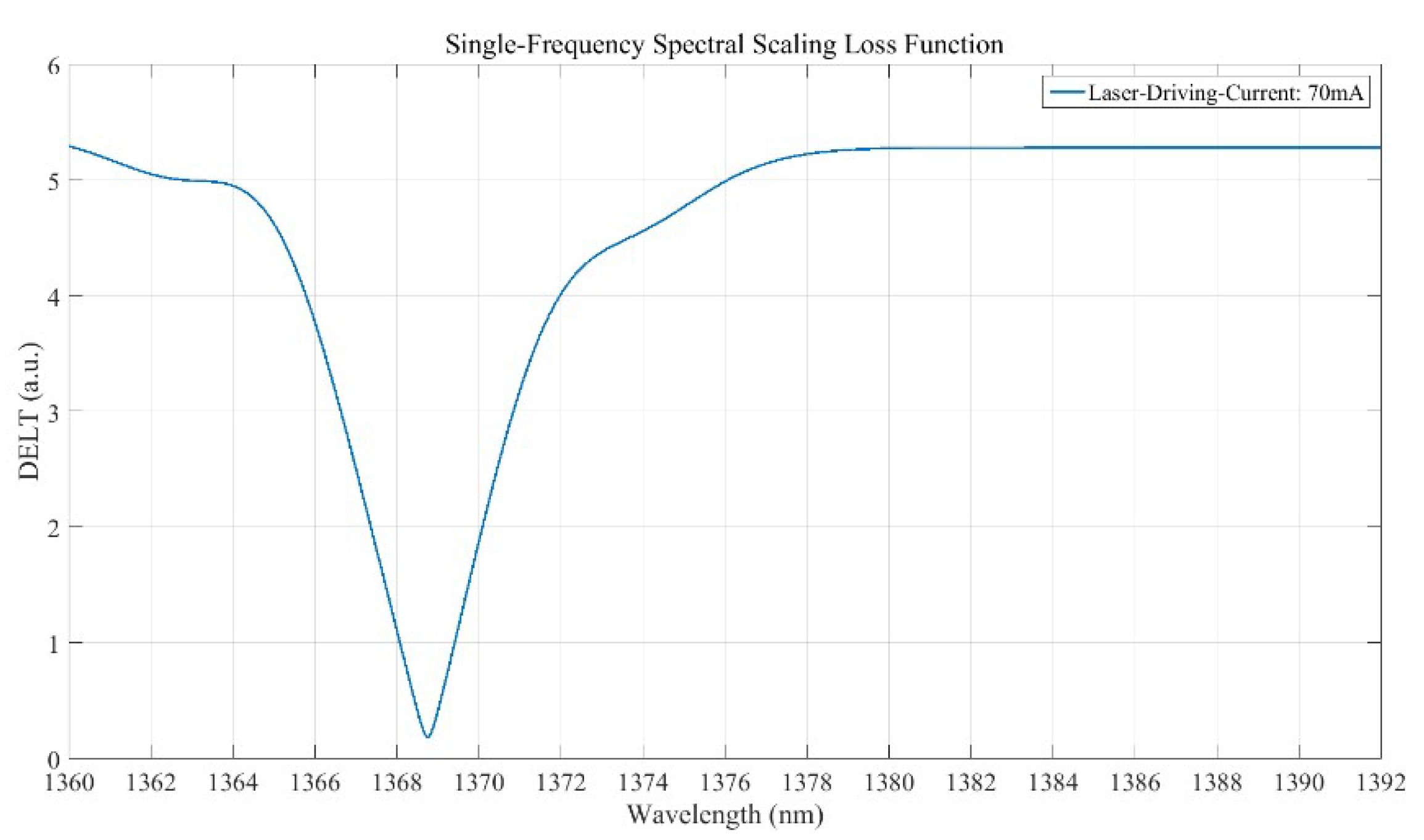1. Introduction
As an image–spectrum merging technology, hyperspectral imaging has been widely used in agriculture, ocean observations, urban planning, disaster monitoring, and many other fields [
1,
2,
3]. The quantitative retrieval of a target’s surface spectral reflection characteristics is one of the important features of hyperspectral imagers, requiring an accurate spectral position for the instrument. For an imaging spectrometer with a 10 nm full width at half maximum (FWHM), a spectral shift of 1 nm shows relative errors of up to ±25% in the measured radiance near strong atmospheric absorption valleys [
4]. The Jet Propulsion Laboratory (LaKan Yada and Pasadena, America) has reported that a measured radiance error of about 8% occurs when spectral calibration accuracy approaches 5% of the FWHM in the atmospheric absorption range [
5]. High-precision spectral calibration is indispensable in the field of hyperspectral remote sensing applications. The popular methods for spectral calibration are divided into two main categories: The characteristic spectrum calibration method (CSCM), which relies on sources with unique spectral properties, such as tunable lasers [
6], filters containing rare earth oxides [
7], atmospheric characteristic absorption lines [
8,
9], gas molecules absorb cells [
10], spectrum lamps [
11], etc. The other is a monochromatic and collimator-based wavelength scanning calibration method, called the monochromatic collimation light calibration method (MCLCM). The advantage of CSCM is that it is easy to operate and can quickly detect the spectral offset of the spectrometers. Its disadvantage is that the spectral characteristic is untunable or the tunable spectrum range is narrow and cannot cover the whole operation spectral range of the spectrometer. The absolute uncertainty of CSCM can approach 10% of the spectrum sampling interval of the responsive channel, which could meet practical requirements.
The monochromatic collimation light calibration method can realize high-precision continuous wavelength scanning in a wide spectral range, which is generally adopted by scholars. One of moderate resolution imaging spectroradiometer’s (MODIS) on-orbit calibration methods is to use a spectro-radiometric calibration assembly (SRCA) to calibrate the offset of center wavelength and the deviation of FWHM [
12,
13]. Zadnik et al. successfully calibrated the spectral response function of compact airborn spectral sensor (CAMPASS) in a laboratory using a high-resolution monochromator with an absolute calibration accuracy of ±0.5 nm [
14]. The monochromatic collimated spectrum calibration method has gradually become the first choice for spectral calibration of spectrometers, but the uncertainty of the monochromator’s stability has always been the bottleneck limiting the accuracy of spectrometers. In response to such problems, Zhang et al. [
15] analyzed the relationship between the mechanical error of the monochromator system and the wavelength of the emitted light and established a mathematical model to calculate the monochromatic light’s wavelength offset. The calibration accuracy is
nm. The European Space Agency calibrated the monochromator via a HeNe laser and a series of gas atomic lamps (Hg, Ne, Ar, Kr, and Xe). The absolute spectral uncertainty of the airborne prism experiment (APEX) was increased to
nm [
16]. With the enhancement of the spectral resolution of the hyperspectral imager, the calibration accuracy of MCLCM in laboratory is continuously improving. However, for hyperspectral imagers with a 3-nm spectral sampling interval, the effect of water vapor absorption on the spectral calibration accuracy of the channels located in an absorptive wavelength range is gradually being understood. Unlike the hyperspectral imagers in a space remote sensing field, laboratory spectral calibration for hyperspectral imagers in an aerial remote sensing application was performed under a normal atmospheric environment. Due to the strong absorptive effect of water vapor in 1350–1420 nm and 1820–1940 nm, the actual digital number (DN) response curves of hyperspectral imagers obtained by MCLCM deviate from the Gaussian shape, which leads to a decrease in the calibration accuracy of the channel’s spectral response function. We studied the actual DN response curve in the wavelength range mentioned above and found that each absorption valley along the actual DN response curve of every spectral channel located in the absorptive range corresponds to the spectral absorption characteristics of water vapor. This phenomenon not only helps us to solve the problem of the decrease in the spectral calibration accuracy of the spectral channels, but also corrects the wavelength offset of the monochromator simultaneously. The water vapor spectral calibration method (WVSCM) is an improved laboratory spectral calibration method based on monochromator and transmittance characteristics of water vapor. WVSCM can promote the application of hyperspectral imagers in the aerospace field.
In the second section of this paper, we introduce the laboratory spectral calibration principle and the water vapor spectrum calibration method for the hyperspectral imagers. In
Section 3, the experimental verification of the WVSCM and the wavelength offset of the monochromator being removed simultaneously are described. The
Section 4 provides the error analysis and effectiveness validity of the WVSCM. The experimental results in this paper were consistent with the theory, which confirmed the feasibility of the water vapor spectrum calibration method.
2. Methods
The spectral response function of an imaging spectrometer applies the relative response ability of each spectral channel to different wavelength monochromatic light. The spectral response function can be expressed as a convolution of the slit function, the spectrometer optical system line spread function, and the detector pixel response function [
17]. The hyper-spectrometer uses an optical system of a prism or grating to split light and map between objects and their images. A charge-coupled device (CCD) focal plane detector and its electronic system are used to accomplish the process of photoelectric information conversion, amplification, sampling, quantization, and coding. If we assume the spectral radiance at a monochromator’s exit slit is
L(
λ), the atmospheric transmittance is
v(
λ), the energy transfer efficiency of the optical system is
τ(
λ), the distribution function of the dispersive system is
ψ(
λ), the quantum efficiency of the CCD pixels is
ηd(
λ), the spectral response efficiency of the electronic system is
ηe(
λ), the charges’ conversion coefficient from the quantum well to CCD output voltage is
κ, the total voltage gain coefficient of the detector’s matching circuits is
G, the total noise voltage introduced by the process of photoelectric conversion and voltage amplification is
n, the quantization bit of the ADC chip is
m, and the quantization reference voltage is
VREF, then the DN value generated during the integral time
T can be expressed as
where
is the size of the detector’s pixel,
is the aperture of the optical system,
is the focal length of optical system, and
and
are the Planck constants and the speed of light, respectively. If we use
and
to represent the absolute radiation transfer coefficient of the hyperspectral imager, and
as the spectral response function, then Equation (1) can be rewritten as
For practical convenience, the spectral response function
is usually expressed by a Gaussian function [
18], as shown in Equation (3). The subscripts
i and
j in Equation (3) denote the pixel in the
j-th spatial sequence and the
i-th spectrum sequence of the CCD focal plane.
is the center wavelength position, FWHM is the full width at half maximum, and
is the relative spectral response efficiency of pixel
i j:
If the wavelength of a bundle of monochromatic light received by the spectrometer is recorded as , the DN response value of pixel i j can be written as
In the wavelength range without the effect of atmospheric absorption, the DN value is the linear gain of the spectral response function. It can be accurately calibrated by the actual DN response curve. However, when the influence of the atmosphere cannot be ignored, especially in the strong absorptive wavelength range of 1350 nm to 1420 nm and 1820 nm to 1940 nm caused by water vapor, the actual DN response curve deviates from the Gaussian shape, which cannot reflect the characteristic of the spectral response function accurately. Take pixel
i j located within the strong absorptive range as an example, then we use Gaussian function
(λ) shown in Equation (5) to represent its original DN response function, which is obtained by Gauss fitting of the pixel’s actual DN curve:
(
λ):
(λ) is just an approximation of
(
λ), which is the intrinsic DN response function of pixel
i j. We can solve function
(
λ) by fitting the actual and the simulated (theoretical) DN response curve based on the spectral absorption characteristics of water vapor. If we set the atmospheric transmittance as
v(
λ) and introduce the relative DN response height variation ∆
P, the offset of the center wavelength ∆
λ, and the stretch of the full width at half maximum ∆
FWHM into Equation (5), then we create the difference function
to represent the difference distance between the simulated DN response curve and the actual one, which is expressed in Equation (6):
The set of solutions in Equation (6) is a three-dimensional (3D) cube matrix, which is shown in
Figure 1. By bringing the solutions of the global minimum value
back into Equation (5), we can determine the real intrinsic DN response function
(λ), as shown in Equation (7). The parameter
P0,
FWHMstretch, and
λshift are the solutions of
:
The content mentioned above provides the theoretical basis and calculation process of the water vapor spectral calibration method (WVSCM). By repeatedly using the WVSCM, we could calibrate the intrinsic DN response functions of all spectral channels located in the wavelength range of 1350 nm to 1420 nm and 1820 nm to 1940 nm one at a time. The spectral response functions can be determined simultaneously. We verified the WVSCM through experiments, which are described in
Section 3.
3. Experiment Validation
The laboratory temperature was 18 degree Celsius, the relative humidity was 34%, and the partial pressure of water vapor in the air was around 700 Pascal. The optical distance of monochromatic light was about 3 m. The laboratory spectral calibration structure is shown in
Figure 2.
The instrument for wavelength scanning was an iHR550 monochromator produced by HORIBA, Ltd. (Kyoto, Japan), and the calibration light source was an LSH-250 tungsten halogen lamp. The spectrometer for spectral calibration was a full spectral airborne hyperspectral imager (FSAHI) [
19,
20,
21], which was developed by the Shanghai Institute of Technical Physics, Chinese Academy of Sciences (Shanghai, China). The main FSAHI parameters are shown in
Table 1.
We selected the middle field view of FSAHI to receive the monochromatic light, and the wavelength scanning step of the monochromator was 0.2 nm. The actual DN response curves covering the range of 1320 nm to 1550 nm and 1780 nm to 1980 nm are shown in
Figure 3 and
Figure 4, respectively. The absorption of water vapor could cause the actual DN response curve to deviate from the Gaussian shape. This phenomenon is consistent with the theory presented in
Section 2.
Taking the
i-th channel with a center wavelength around 1376 nm in
j-th spatial sequence as an example, we used the WVSCM to calculate the pixel’s intrinsic DN response function
(
λ), as shown by the solid black line in
Figure 5. The red dotted and dashed line is the actual DN response curve
(
λ). The green dashed line is the original DN response function curve obtained by Gaussian fitting of
(
λ). The blue short dashed line in
Figure 5 is the simulated DN response curve, which is the product of
(
λ) and
v(
λ) in the wavelength direction.
Although, the simulated DN response curve has a high degree of similarity with the actual curve, a misalignment between them was apparent. This phenomenon is mainly caused by the difference between the spectral positions of the monochromator and the MODTRAN model. Since the state of monochromator changes with time, it is necessary to calibrate the spectral deviation of the monochromator using MODTRAN. We used the least-square method to fit
(
λ) and the simulated response curve to obtain the best matching spectral position via translating the actual DN response curve, as shown in
Figure 6. The translation distance of the actual DN response curve is the spectral offset of the monochromator, which we recorded as ∆
λmono.
By using the WVSCM to analyze the channels of the
j-th spatial sequence located in the wavelength range of water vapor absorption, the actual DN response curves and the simulated ones could be obtained, as shown in
Figure 7. After completing the overall translation on the actual DN response curves with ∆
λmono, shown in
Figure 8, the simulated and actual response curves were consistent with each other. The wavelength offset of the monochromator was removed.
4. Result Analysis
According to the wavelength position of each absorptive valley of water vapor in the wavelength range of 1350 to 1430 nm and 1800 to 1960 nm provided by the MODTRAN model, we performed statistics on the wavelength position deviations of the 132 absorptive valleys between the translated actual DN response curves and the theoretical DN response curves. The wavelength deviations of each valley are shown in
Figure 9.
Among the absorptive sample points, the maximum positive offset was 0.11 nm, and the maximum negative offset was 0.14 nm. Their root mean square error was 0.07 nm. The average full width at half maximum (FWHM) of FSAHI is 4.70 nm. Therefore, it is reasonable to think that the absolute accuracy of spectral calibration is ±0.125 nm. A 4.5% level of FWHM accuracy, which refers to three times the root mean square error, was achieved.
The WVSCM takes the spectral position of MODTRAN as the benchmark to calibrate the spectrometer and monochromator. To verify the effectiveness of MODTRAN, we performed an imaging experiment with two tunable single-frequency semiconductor lasers to examine the spectral calibration results of the WVSCM. The principle of the experiment is shown in
Figure 10.
The single-frequency semiconductor laser (SFSL) applied in this experiment used a Distributed Feedback (DFB) laser with an integrated Thermoelectric Cooler (TEC) module. By adjusting the magnitude of the drive current, small range modulation of the monochromatic light’s wavelength can be achieved [
22,
23]. Since the response efficiency of different spectral channels to the same monochromatic light differ, we ascertained the wavelength of the laser by a hyperspectral imager according to this phenomenon. We used the WVSCM to calibrate the intrinsic DN response functions of the
j-th spatial sequence, as shown in
Figure 11. The responsive DN values of the spectral channels that responded significantly to the monochromatic light
λ0 arranged from large to small were recorded as:
,
,
,
and
. Therefore, we defined the single-frequency spectral scaling loss function DELT(
λ) in Equation (8), according to
Figure 11:
where
is the normalization gain coefficient of each channel’s intrinsic DN response function. The purpose of normalization is to eliminate the effects of noise levels in different channels.
is the minimum DN response value among the channels and
is the matching weight of the channels, which decreases with decreasing
.
The intrinsic wavelengths of lasers were calibrated using a HighFinesse-WS8 wavelength meter produced by the HighFinesse Company (Munich, Germany). The results of the loss function
DELT(
λ) are a function of wavelength
λ, as shown in
Figure 12. The wavelength position corresponding to the minimum value of DELT(
λ) is the monochromatic wavelength of laser calibrated by FSAHI. The measurement results of two different semiconductor lasers measured by HifghFinesse-WS8 and FSAHI under different driving currents are shown in
Table 2 and
Table 3.
